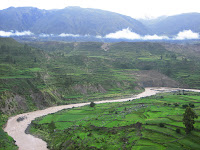 From Cusco we flew to Puerto Maldonado. After a quick stop we boarded a canoe to begin our journey upstream to the jungle lodge. We arrived at the lodge at 6:30pm, already dark but we had our flashlights ready. The lodge exceeded expectations. The place is well maintained- very clean. Although the showers only have cold water there are flush toilets and the sleeping quarters are built up off of the ground (no jungle critters greeting you in the morning). Soon after our arrival a large, excellent buffet was ready. With such a long day of travel the night ended early and I retired to my bed, complete with mosquito netting.
From Cusco we flew to Puerto Maldonado. After a quick stop we boarded a canoe to begin our journey upstream to the jungle lodge. We arrived at the lodge at 6:30pm, already dark but we had our flashlights ready. The lodge exceeded expectations. The place is well maintained- very clean. Although the showers only have cold water there are flush toilets and the sleeping quarters are built up off of the ground (no jungle critters greeting you in the morning). Soon after our arrival a large, excellent buffet was ready. With such a long day of travel the night ended early and I retired to my bed, complete with mosquito netting.
Our activities were delayed in the morning due to a down pour (imagine that, rain in the rainforest). But soon enough the weather cleared and we paid a visit to a farm across the river. We tried a few different fruits grown on the land, some were very sour. At the farm we were able to see a few monkeys hanging and swinging from the trees. Crops are usually lower in numbers due to the monkeys and other animals taking their share.
Our jungle excursion was slick and muddy. Not much wildlife was seen, just a small snake, cutter ants and some sort of weasel. We heard the sound of wild pigs, followed the noise for a little while but never saw them. Early the next morning we bid farewell to the jungle and made our return trip to Puerto Maldonado and then back to Lima.

I spent my last day in Peru visiting the site of Pachacamac and the Museum of Gold. Pachacamac is an expansive site but lies in ruins. Unfortunately some of the site has seen development, and not legally. A family builds a home, others follow suit, a whole town springs up quickly and the government doesn't do much about it because of the cost and the strength of the new town. There are a few things about Peru I don't understand, this and the lack of taxes are two things.
The museum of gold has a large collection of artifacts from numerous cultures of Peru. A few skulls I saw I thought were victims of trepanation but instead these skulls were worn around the waist of a warrior to show his prowess.
Before I left for the airport I had my last meal in Peru at Bembo's- the Peruvian McDonald's. The food at Bembo's is better.
My adventures in Peru were fantastic! Traveling with great people and a fun, friendly guide always helps.
Next up: Mexico and Central America!



























